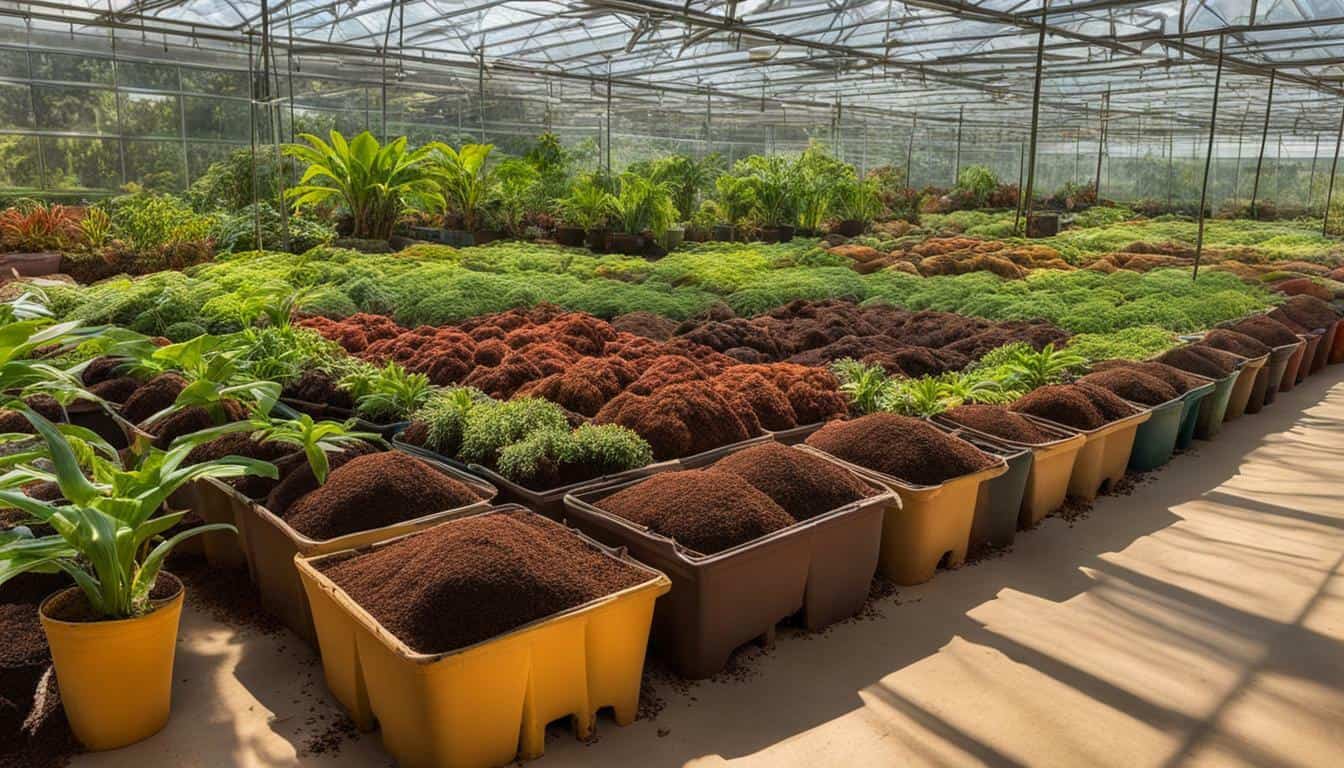Coco coir, a natural and eco-friendly growing medium, is widely used in gardening. But does it go bad over time? Many gardeners wonder about the shelf life of coco coir and how to maintain its effectiveness for their plants. In this article, we will delve into the longevity of coco coir, discussing factors that can affect its shelf life and why proper storage is crucial. We will also explore reconditioning and reusing coco coir, alternative uses for used coir, and various gardening applications. By the end of this article, you will have a comprehensive understanding of how to make the most of your coco coir and ensure its longevity.
Key Takeaways:
- Coco coir does not have an expiry date but can stay usable for up to three years if stored correctly.
- Factors such as moisture, temperature, and storage conditions can affect the shelf life of coco coir.
- Proper storage in a cool, dry place is essential for maintaining the effectiveness of coco coir.
- Reconditioning and reusing coco coir can be cost-effective, sustainable, and provide consistent growing conditions.
- Enzymes can be used to break down dead root material in reused coco coir, restoring its structure and nutrient content.
Factors Affecting Coco Coir Shelf Life
Several factors can influence the shelf life of coco coir, including moisture, temperature, and storage conditions. These elements play a crucial role in determining whether your coco coir remains effective for an extended period. Let’s explore these factors in more detail:
- Moisture: Coco coir is highly absorbent, making it susceptible to mold and bacterial growth if exposed to excessive moisture. To prevent degradation, it is essential to store coco coir in a cool, dry place and protect it from any water sources.
- Temperature: Extreme heat or cold can impact the longevity of coco coir. High temperatures can lead to the breakdown of its organic structure, while freezing temperatures can cause the coir to lose its effectiveness. It is crucial to store coco coir in an environment with a stable temperature range.
- Storage Conditions: Proper storage conditions are vital for maintaining the quality of coco coir. Storing it in a cool, dry place away from direct sunlight helps prevent moisture accumulation and temperature fluctuations. Using airtight containers or bags can further protect the coir from exposure to air and humidity.
By understanding and addressing these factors, you can maximize the shelf life of your coco coir, ensuring its effectiveness for your gardening needs.
“Proper storage conditions are vital for maintaining the quality of coco coir.”
Summary:
Factors such as moisture, temperature, and storage conditions significantly impact the shelf life of coco coir. Exposure to excessive moisture can lead to mold and bacterial growth, while extreme temperatures can cause degradation. Storing coco coir in a cool, dry place and protecting it from water sources and temperature fluctuations is crucial for maintaining its effectiveness. Using airtight containers or bags can further enhance storage conditions. By considering these factors and implementing proper storage practices, you can extend the shelf life of your coco coir and maximize its benefits for your gardening endeavors.
| Factors | Impact on Coco Coir Shelf Life |
|---|---|
| Moisture | Mold and bacterial growth |
| Temperature | Structure breakdown or loss of effectiveness |
| Storage Conditions | Quality preservation |
Proper Storage for Maintaining Coco Coir Effectiveness
To ensure coco coir remains effective, proper storage is crucial. Coco coir, a natural and eco-friendly growing medium, can have a long shelf life when stored correctly. Moisture, temperature, and storage conditions can all impact its longevity and overall quality. It is important to store coco coir in a cool, dry place away from direct sunlight.
“Proper storage conditions play a significant role in maintaining the quality of coco coir.”
When storing coco coir, consider using airtight containers or bags to prevent exposure to air and humidity. This helps to preserve its moisture content and prevent mold or bacterial growth. Additionally, keeping coco coir away from extreme temperatures is crucial as it can lead to degradation and reduce its effectiveness.
By following these storage guidelines, coco coir can remain usable for up to three years. This is particularly beneficial for those who reuse coco coir, as proper storage ensures its reconditioned form retains its structure, nutrient content, and overall effectiveness. By maximizing the longevity of coco coir through correct storage practices, growers can enjoy the cost-effectiveness and sustainability offered by this versatile growing medium.

Table: Proper Storage Recommendations for Coco Coir
| Storage Factor | Recommendation |
|---|---|
| Moisture | Store in a dry place away from moisture sources. |
| Temperature | Avoid exposure to extreme temperatures. |
| Storage Container | Use airtight containers or bags to prevent air and humidity exposure. |
| Light | Keep away from direct sunlight. |
| Duration | Use within three years of storage for optimal results. |
Reconditioning and Reusing Coco Coir
Instead of discarding used coco coir, it can be reconditioned and reused, offering several benefits for gardeners. Reusing coco coir is not only cost-effective but also promotes sustainability by reducing waste. By following a few simple steps, you can restore the effectiveness of your coco coir and ensure consistent growing conditions for your plants.
First, remove any non-coco related debris from the coco coir. This can include root fragments, plant material, or any other foreign objects that may have accumulated. By eliminating these unwanted elements, you can create a clean and nutrient-rich medium for your plants.
Next, thoroughly wash the coco coir to remove any residual contaminants. This can be done by soaking the coir in water and gently agitating it to dislodge any impurities. Rinse the coir multiple times until the water runs clear, ensuring that all traces of contaminants are removed.
After washing, it is important to adjust the pH level of the coco coir. Coco coir has a natural tendency to be slightly acidic, so it is recommended to raise the pH to a more neutral level. This can be achieved by adding materials such as dolomite lime or agricultural lime, following the manufacturer’s instructions for the appropriate dosage.
Once the pH has been adjusted, sterilize the coco coir to eliminate any remaining pathogens or pests. This can be done by steaming the coir or using a commercial sterilizing agent. Sterilization ensures a clean and disease-free growing medium for your plants.
By reconditioning and reusing coco coir, you not only save money but also maintain consistency in your growing conditions. It provides a sustainable alternative to traditional growing mediums and helps reduce the environmental impact of gardening. So why discard when you can reuse and reap the benefits?
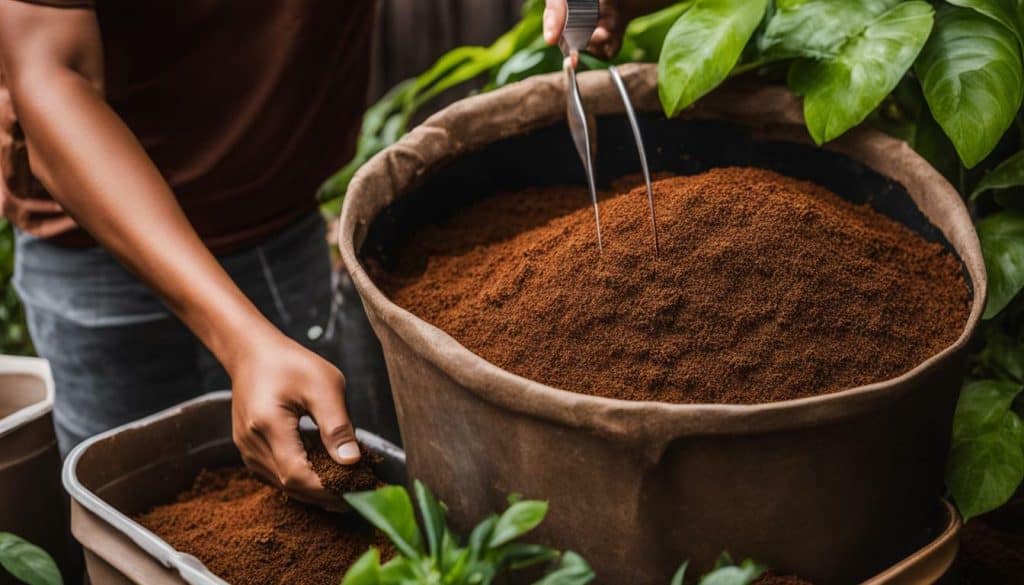
| Benefits of Reusing Coco Coir |
|---|
| Cost-effective |
| Promotes sustainability |
| Consistent growing conditions |
| Reduces waste |
| Environmentally friendly |
Enzymes for Breaking Down Dead Root Material
Enzymes can be a valuable tool for breaking down dead root material in reused coco coir. When coco coir is reused, it may contain remnants of previous plant roots, which can hinder its effectiveness as a growing medium. The presence of dead root material can lead to nutrient imbalances and decreased oxygen availability for new plants. That’s where enzymes come in.
Enzymes are natural substances that catalyze chemical reactions, and specific enzymes can be used to break down dead root material in coco coir. These enzymes work by breaking down complex organic compounds into smaller, more readily available forms that can be easily absorbed by plants. By using enzymes to break down dead root material, the coco coir can be reconditioned and its nutrient content restored, providing an optimal environment for new plant growth.
It is important to note that not all enzymes are suitable for coco coir. Enzyme products specifically designed for coco coir should be used to ensure compatibility and effectiveness. These products are usually formulated to target the specific compounds present in coco coir, maximizing the breakdown process and promoting a healthy growing environment.
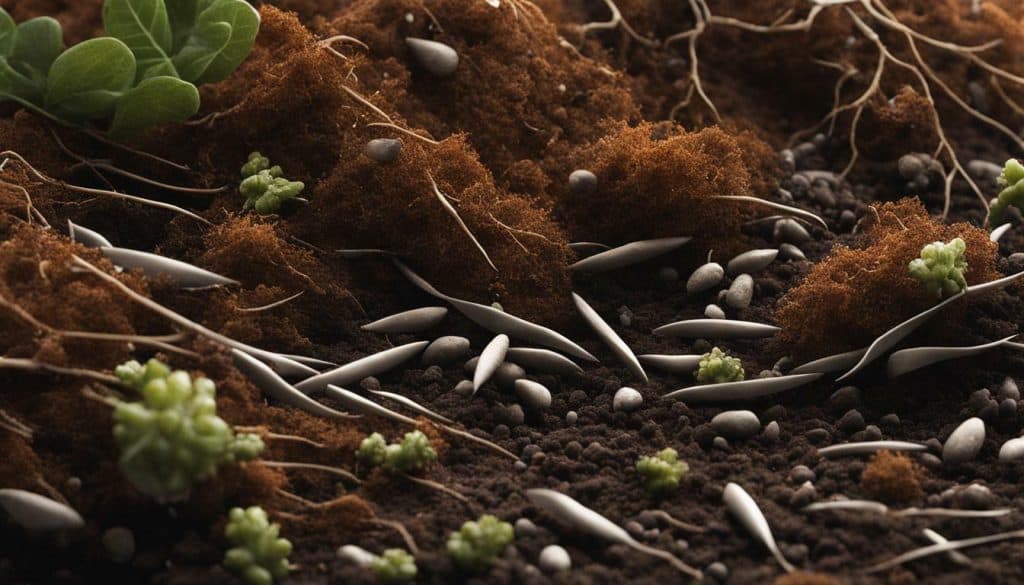
| Benefits of Enzymes for Breaking Down Dead Root Material | Application |
|---|---|
| Restores the structure of coco coir for optimal root development | Hydroponic systems, container plants |
| Enhances nutrient availability for new plants | Seed starting, vegetable gardens |
| Reduces the risk of disease and pest problems | Flower beds, climbing plants |
| Improves overall plant health and growth | Hanging planters, biodegradable pots |
Using enzymes to break down dead root material in reused coco coir not only benefits the plants but also contributes to sustainable gardening practices. By reconditioning the coco coir, growers can reduce waste and minimize their environmental impact. It is essential to follow the manufacturer’s instructions when using enzyme products and to ensure proper storage of the coco coir to maintain its effectiveness over time.
Alternative Uses for Used Coco Coir
Don’t throw away used coco coir, explore its alternative uses in your garden. This eco-friendly and versatile growing medium can be repurposed in various ways, contributing to sustainable gardening practices and minimizing waste. Here are some creative and practical ways to make the most out of your used coco coir:
- Mulching: Spread a layer of shredded coco coir around your plants to retain moisture, suppress weeds, and regulate soil temperature. It provides excellent insulation for your garden beds and acts as a natural barrier against soil erosion.
- Composting: Incorporate shredded coco coir into your compost pile as a carbon-rich “brown” material. Its fibrous texture helps improve aeration and moisture retention in the compost, resulting in faster decomposition and nutrient-rich humus.
- Soil Amendment: Mix coco coir with your garden soil to enhance its structure and water-holding capacity. It improves drainage in heavy clay soils and increases moisture retention in sandy soils, creating a balanced environment for plant roots.
- Pet Bedding: Line your furry friend’s bed or litter box with coco coir to provide a comfortable and absorbent surface. It naturally absorbs odors and moisture, keeping your pet’s sleeping area clean and fresh.
- Erosion Control: Use coco coir logs or mats to prevent soil erosion on slopes or areas prone to runoff. These biodegradable materials help stabilize the soil, promote vegetation growth, and protect against sedimentation in water bodies.
“Coco coir is a fantastic resource for gardeners seeking sustainable solutions. Its ability to retain moisture, improve soil structure, and minimize waste makes it an invaluable asset in any garden. By exploring alternative uses for used coco coir, we can reduce our environmental impact and create a more resilient and thriving garden.”
Remember to break down any large chunks of coco coir before using it in your garden. This will help it integrate more easily with the soil and maximize its benefits. Whether you choose to mulch, compost, amend the soil, use it as pet bedding, or control erosion, the possibilities with used coco coir are endless.
| Alternative Use | Description |
|---|---|
| Mulching | Spread shredded coco coir around plants for moisture retention, weed suppression, and soil insulation. |
| Composting | Incorporate shredded coco coir into compost to improve aeration and moisture retention. |
| Soil Amendment | Mix coco coir into garden soil to enhance drainage and water-holding capacity. |
| Pet Bedding | Line pet beds or litter boxes with coco coir for odor absorption and moisture control. |
| Erosion Control | Use coco coir logs or mats to stabilize soil and prevent erosion on slopes or runoff-prone areas. |
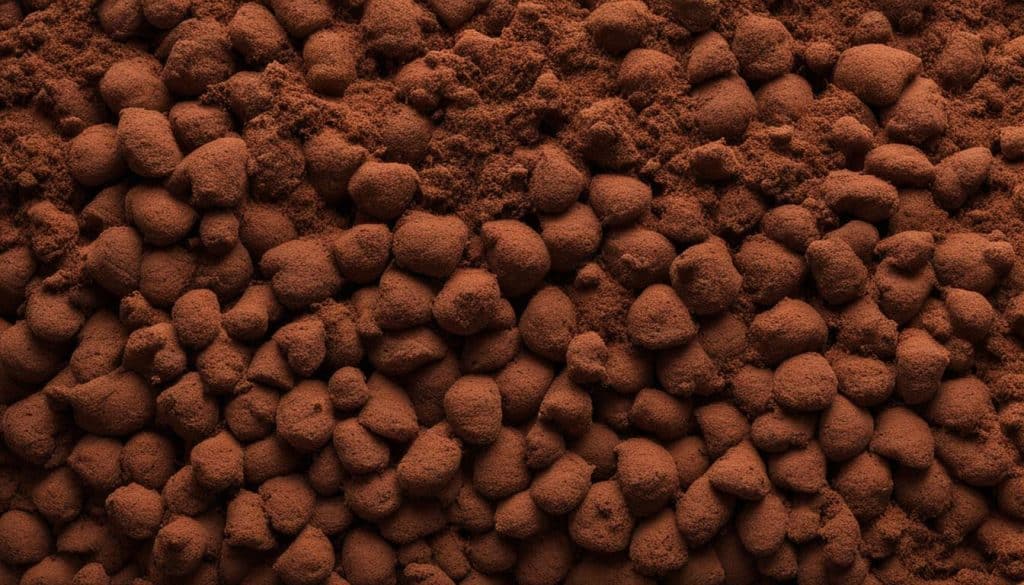
Coco coir is truly a garden superhero, capable of benefiting your plants, the environment, and your budget. So, think twice before discarding your used coco coir and explore its alternative uses to harness its full potential in your garden.
FAQs About Coco Coir Longevity
Here are some frequently asked questions regarding the longevity of coco coir and their respective answers:
- Can I still use coco coir that is past its expiration date?
- Is it possible to reuse coco coir?
- How can I break down dead root material in reused coco coir?
- What are some alternative uses for used coco coir?
No, coco coir does not have an expiration date. However, its shelf life can be affected by factors such as moisture, temperature, and storage conditions. If stored correctly in a cool, dry place, coco coir can stay usable for up to three years.
Yes, coco coir can be reconditioned and reused. To do so, remove any non-coco related debris, thoroughly wash the coir, adjust the pH level, and sterilize it before reuse. Reusing coco coir has several benefits, including cost-effectiveness, sustainability, consistency in growing conditions, and a reduction in pest and disease problems.
Enzymes can be used to break down dead root material in reused coco coir. These enzymes help restore the coir’s structure, nutrient content, and remove any residual contaminants. It is important to use enzyme products specifically designed for coco coir to ensure optimal results.
Used coco coir can have alternative applications such as mulching, composting, soil amendment, pet bedding, and erosion control. Repurposing coco coir in these ways contributes to sustainable gardening practices and reduces waste.
Summary
Coco coir does not have an expiration date but its shelf life can be affected by factors such as moisture, temperature, and storage conditions. Reusing coco coir is possible and has several benefits, including cost-effectiveness and sustainability. Enzymes can be used to break down dead root material in reused coco coir, and used coco coir can be repurposed for various gardening applications. By implementing proper storage practices and exploring alternative uses, coco coir can be maximized in its longevity and contribute to more sustainable gardening practices.
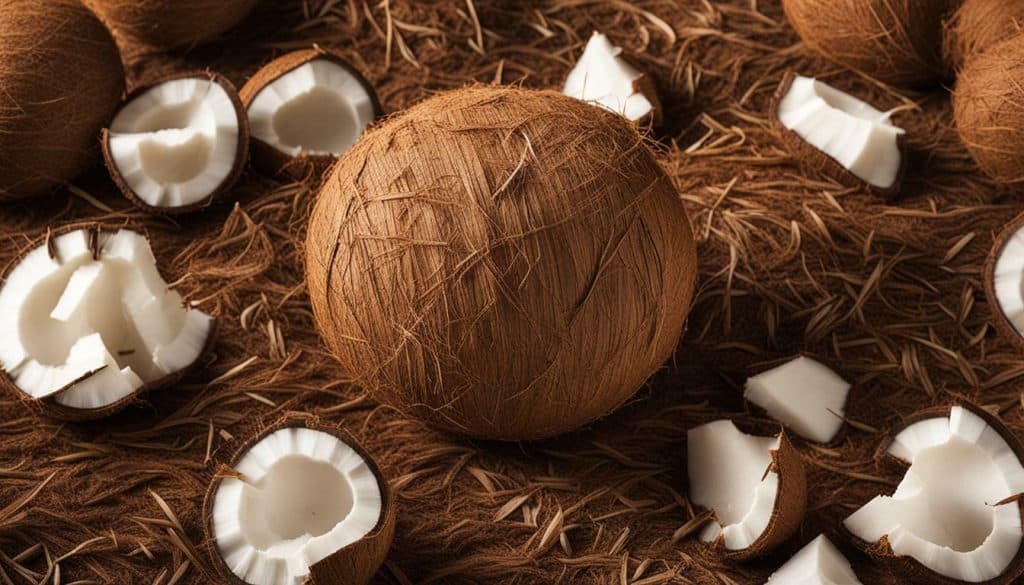
Various Gardening Applications for Coco Coir
Coco coir can be utilized in a variety of gardening applications, offering versatility and excellent results. Whether you’re a seasoned gardener or a beginner, coco coir can be a valuable addition to your gardening arsenal. Its unique properties make it suitable for various gardening needs, providing a sustainable and eco-friendly alternative to traditional growing mediums.
One of the popular uses for coco coir is in hanging planters. Its moisture-retaining abilities make it an ideal choice for plants that need regular watering but don’t want to be overwatered. Coco coir can also be used in hydroponic systems, providing a lightweight and nutrient-rich medium for plant growth.
For vegetable gardens and flower beds, coco coir can improve soil structure and water retention. It can be used as a soil amendment to enhance drainage in clay soils or retain moisture in sandy soils. Coco coir is also a great option for seed starting, providing a loose and airy environment for seeds to germinate and develop strong root systems.
| Gardening Application | Benefits of Using Coco Coir |
|---|---|
| Container Plants | Lightweight, good drainage, and retains moisture |
| Climbing Plants | Provides support and retains moisture |
| Biodegradable Pots | Eco-friendly alternative to plastic pots |
“Coco coir provides a sustainable and eco-friendly alternative to traditional growing mediums.”
Coco coir can also serve various other purposes in the gardening realm. It can be used for mulching, which helps retain moisture in the soil, suppresses weed growth, and moderates soil temperature. Additionally, coco coir can be composted, contributing to soil fertility and organic matter. It can also be used as pet bedding, thanks to its natural ability to absorb moisture and control odor. Lastly, coco coir can be utilized for erosion control, preventing soil erosion in areas prone to heavy rainfall or erosion.
When using coco coir in your gardening endeavors, it’s important to store it properly in a cool, dry, and sun-free spot. This ensures its longevity and effectiveness, allowing you to reap the benefits for an extended period. By implementing proper storage practices, you can maximize the shelf life of your coco coir and optimize your gardening experience.

Importance of Proper Storage for Coconut Coir
Taking proper care and storing coconut coir correctly is crucial to maintain its quality and effectiveness. Coco coir, a natural and eco-friendly growing medium, does not have an expiry date, but its shelf life can be affected by factors such as moisture, temperature, and storage conditions. To ensure the longevity of your coconut coir and maximize its usability, it’s essential to follow proper storage practices.
First and foremost, coco coir should be stored in a cool, dry place away from direct sunlight. Moisture can lead to mold and bacterial growth, while extreme temperatures can cause degradation. By storing your coconut coir in a cool, dry spot, you can protect it from these damaging effects. An airtight container or bag can also be beneficial in preventing exposure to air and humidity.
Reconditioning and reusing coco coir is another way to extend its lifespan and reduce waste. By removing non-coco related debris, washing it thoroughly, adjusting the pH level, and sterilizing it before reuse, you can restore its structure, nutrient content, and remove any residual contaminants. This process not only saves money but also promotes sustainability and ensures consistent growing conditions.
| Proper Storage Guidelines for Coconut Coir |
|---|
| Store in a cool, dry place |
| Avoid direct sunlight |
| Use an airtight container or bag to prevent exposure to air and humidity |
| Recondition and reuse coco coir for extended usability |
Additionally, enzymes can be used to break down dead root material in reused coco coir, further enhancing its effectiveness. This process helps restore the coir’s structure, nutrient content, and eliminates any remaining contaminants. It’s important to ensure you’re using enzyme products specifically designed for coco coir for optimum results.
It’s worth noting that used coconut coir can have alternative applications beyond its primary use as a growing medium. It can be utilized as mulch, added to compost, used as a soil amendment, or even repurposed as pet bedding or for erosion control. By exploring these alternative uses, you can further contribute to sustainable gardening practices.
By following these guidelines and taking proper care of your coconut coir, you can maintain its quality, maximize its shelf life, and enjoy the benefits of a versatile and effective growing medium.

Conclusion
Coco coir, when stored correctly, can be a long-lasting and versatile growing medium, providing numerous benefits for gardeners. While coco coir does not have an expiry date, its shelf life can be influenced by factors such as moisture, temperature, and storage conditions. It is crucial to store coco coir in a cool, dry place to maintain its effectiveness. By following proper storage practices, coco coir can remain usable for up to three years.
Reconditioning and reusing coco coir is also an excellent way to maximize its lifespan and minimize waste. By removing non-coco related debris, washing thoroughly, adjusting the pH level, and sterilizing it, coco coir can be rejuvenated for further use. Not only does this approach save costs, but it also promotes sustainability and consistency in growing conditions.
Enzymes play a vital role in breaking down dead root material in reused coco coir, restoring its structure, and removing residual contaminants. Additionally, used coco coir has alternative applications such as mulching, composting, soil amendment, pet bedding, and erosion control. By repurposing coco coir instead of disposing of it, gardeners can contribute to sustainable gardening practices.
Addressing frequently asked questions about coco coir longevity provides valuable information for gardeners. Understanding topics such as reusing old coco coir, the reuse limit, bacterial growth, nutrient requirements, moisture effects and buffering, flushing frequency, addressing mold growth, and feeding frequency helps ensure the optimal use of coco coir.
Furthermore, coco coir can be utilized in various gardening applications, including hanging planters, hydroponic systems, vegetable gardens, flower beds, seed starting, container plants, climbing plants, and as biodegradable pots. Its versatility and adaptability make it a valuable addition to any gardener’s toolkit.
Proper storage of coconut coir is essential to prevent degradation. Storing it in a cool, dry, and sun-free spot protects its quality and maximizes its longevity. By implementing these storage practices, gardeners can enjoy the benefits of coco coir for an extended period.
FAQ
Q: Does coco coir have an expiry date?
A: Coco coir does not have an expiry date, but its shelf life can be affected by factors such as moisture, temperature, and storage conditions.
Q: How long can coco coir stay usable?
A: If stored correctly in a cool, dry place, coco coir can stay usable for up to three years.
Q: Can coco coir be reconditioned and reused?
A: Yes, coco coir can be reconditioned and reused by removing non-coco related debris, washing it thoroughly, adjusting the pH level, and sterilizing it before reuse.
Q: What are the benefits of reusing coco coir?
A: Reusing coco coir is cost-effective, sustainable, ensures consistency in growing conditions, and reduces pest and disease problems.
Q: How can enzymes be used with reused coco coir?
A: Enzymes can be used to break down dead root material in reused coco coir, helping to restore its structure, nutrient content, and remove any residual contaminants.
Q: What are some alternative uses for used coco coir?
A: Used coco coir can be used for mulching, composting, soil amendment, pet bedding, and erosion control.
Q: Can old coco coir still be used?
A: Yes, old coco coir can still be used as long as it is reconditioned and meets the necessary quality standards.
Q: What are the various gardening applications for coco coir?
A: Coco coir can be used in hanging planters, hydroponic systems, vegetable gardens, flower beds, seed starting, container plants, climbing plants, and as biodegradable pots.
Q: How should coco coir be stored to maintain its quality?
A: Coco coir should be stored in a cool, dry, and sun-free spot to prevent degradation and maintain its quality.
Q: What is the importance of proper storage for coconut coir?
A: Proper storage of coconut coir is essential to prevent degradation, maintain its quality, and maximize its shelf life.
